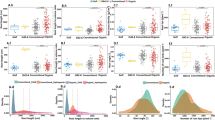Summary
Although the role of roots in plant performance and in tolerating environmental stresses is unquestionable, no much emphasize have been given to roots because of difficulty in assessing root traits. Sixteen barley mutant genotypes, a representative sub-set of a barley mutant collection maintained at Akdeniz University, Turkey, two wild-type cultivars, Kaya, Quantum and one exotic cultivar, Baronesse, were evaluated to assess variability and interrelationships in root traits. The material was grown in a container filled with cocopeat-perlite mixture in a randomized complete blocks design with two replicates in a greenhouse. The longest root length, total root length, shoot length, number of primary root, root dry weight, shoot dry weight and root/shoot dry weight ratio were measured on the 7th, 14th and 21st day, respectively following the sowing date of the genotypes. There were statistically significant differences (p< 0.05) among genotypes for all characters studied. The early heading mutant, M-K-1, selected from Kaya, was superior for total root length and the longest root length comparing with the rest of entries whereas Quantum and its mutant, M-Q-54, had generally superior means for most of the traits measured. The highest broad-sense heritability estimated by variance components method (91 %) was obtained for root dry weight in this population. Regarding relationships among the traits, the strongest correlation was obtained between the longest root length and the total root length (r=0.953**). It was finally concluded that the mutants selected for above-ground characters are also of significant variability for root traits as part of the mutation spectrum.
Similar content being viewed by others
References
Allard R.W. 1960. Principles of Plant Breeding. John Wiley and Sons Inc. New York, USA.
Cagirgan, M.I. ve Yildirim, M.B. 1988. Gama ışınlan uygulanan iki birahk arpa çeşitinde gözlenen makro mutasyonlar ve bunlardan bitki ıslahında yararlanma olanakları, IX. Ulusal Biyoloji Kongresi, Si vas Cilt 1.
Cagirgan, M.I. ve Yildirim, M.B. 1989. Arpa mutant populasyonundaki genotipik varyasyonun belirlenmesi ve seleksiyon yoluyla değerlendirilmesi üzerinde araştırmalar. E. Ü. Fen Bilimleri Enstitüsü Doktora Tezi, Bornova, İzmir.
Cagirgan, M.I., M.B. Yildirim and M.E. Tugay, 1995. A gigantum mutant in barley. Barley Genet. Newsl., 25:21–22.
Cagirgan, M.I., Gorham, J., Toker, C, Uzun, B. and Visser, K. 2002. Evaluation of barley mutants for drought tolerance: a physiology - breeding approach. Mutations, In Vitro and Molecular Techniques for Environmentally Sustainable Crop Improvement In Kluwer Academic Publishers Edited by M. Maluszynski and K.J. Kasha pp.246 Dordrecht/Londan.
Çağırgan, M. İ 1995. Modification of barley mutants differing in heading time by changing the genetic background. Induced Mutations and Molecular Techniques for Crop Improvement. Vienna, Austria, 19–23 June 1995.
Freed, R., Einensmith, S.P., Guetz, S., Reicosky, D., Smail, V.W. and Wolberg, P. 1989. User’s guide to MSTAT-C, an analysis of agronomic research experiments. Michigan State University, USA.
Gai, J. 2002. Establishment of evaluation system and screening for specific accessions with elite root characters and related physiological traits. Report of the 2nd Research Coordination Meeting of FAO/IAEA Co-ordinated Research Project on “Mutational Analysis of root characters in annual food plants related to plant performance”. Krakow, Poland, 10–14 June 2002.
Gaul, H. 1964. Mutations in plant breeding. Radiat.Bot., 4:155–232.
Gaul, H. and Lind, V. 1976. Variation of the pleiotropy effect in a changed genetic background demonstrated with barley mutants. Induced Mutations in Cross Breeding. IAEA, Vienna, pp.55–69.
Grando, S. and Ceccarelli, S. 1995. Seminal root morphology and coleoptile length in wild (Hordeum vulgare ssp. spontaneum) and cultivated (Hordeum vulgare ssp. vulgare) barley. Euphytica, 86: 73–80.
Hetz, W., Frank, H., Michael, S. and Gunter, F. 1996. Isolation and characterization of rtcs, a maize mutant deficient in the formation of nodal roots. The Plant Journal, 10(5), 845–857.
Huang, B. and Gao, H. 2000. Root physiological characteristics associated with drought resistance in tall fescue cultivars. Crop Science, 40:196–203
Kafawin, O.M. 1998. Seed size and water potential effect on germination and early growth two barley cultivars. Dirasat Agriculture Sciences, 25 (3):335–342.
Kün, E. 1996. Tahıllar-I (Serin İklim Tahıllan). Ankara Üniversitesi Ziraat Fakültesi Yayınlan No: 1451 Ders Kitabı:431, pp. 322.
Lejardi M.C. 2002. Morphlogical characterization of wheat mutants and relationship with tolerance to drought. Report of the 2nd Research Co-ordination Meeting of FAO/IAEA Co-ordinated Research Project on “Mutational Analysis of root characters in annual food plants related to plant performance”. Krakow, Poland, 10–14 June 2002.
Motta, R., Attene, G. and Deidda, M. 1993. Genotypic variation in durum wheat root system at different stages of development in a Mediterranean environment. Euphytica, 66:197–206.
Weaver, J.E. 1926. Root development of field crops. Mcgraw-Hill Book Company, Inc. New York: 370 Seventh Avenue, London, pp.181.
Xinggua, Y., Huijun, U., Lipu, D. and Zhiyong, X. 1999. Genetic improvement of wheat for high efficiency of water and nutrient absorption by radiation induced mutations. Chinese Academy of Agriculture Sciences.
Author information
Authors and Affiliations
Corresponding author
Rights and permissions
About this article
Cite this article
Özbaş, M.O., Çağırgan, M.İ. Variability and Relationships of Root Traits in a Subset of Induced Barley Mutant Collection. CEREAL RESEARCH COMMUNICATIONS 32, 119–126 (2004). https://doi.org/10.1007/BF03543289
Received:
Accepted:
Published:
Issue Date:
DOI: https://doi.org/10.1007/BF03543289




